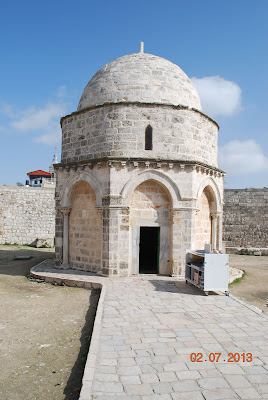This blog follows Jesus from the Garden of Gethsemane to his
ascension to Heaven from the Mount of Olives using some of the photographs we
took. You may notice that the dates on
the photos don’t follow the sequence of events.
We visited the Garden of Gethsemane and the Ascension site several days after following His footsteps through the Old City.
The Garden of Gethsemane contains olive trees that date back
over 2000 years. They are gnarled and
small and the remnants of the Garden is very small.
Remember to click on the photographs to enlarge them.
2000 year old Olive Tree
A section of the Garden of Gethsemane
The
photograph below is taken at the Lion’s Gate into the Old City. This is the closest gate to the Garden of Gethsemane and most likely the gate Christ was brought through after his arrest.
The route Jesus
walked carrying His cross to Calvary is called the Via Dolorosa (Way of Grief
or Way of Suffering). Along this route
are black discs on the walls indicating events that occurred as Jesus carried his cross. Christian tradition says there were 14
events, often referred to as the “14 Stations.”
Nine are along the Via Dolorosa and the last five are in the Church of
the Holy Sepulchre.
Station # I is the location where Jesus was taken before Pontius Pilate. It is now a school in the Muslim Quarter of the old city of Jerusalem.
Station # II is across
the Via Dolorosa from Station # I. It is
now a church and is where Jesus was given his cross to carry. It is just inside the Lion's Gate.
Station #III is where Jesus fell and #IV is where he saw his
mother.
Station #V is where Simon of Cyrene takes up Jesus’s cross
for him.
Station # VII, he fell for the second time.
Station #IX he falls again.
We entered the Church of the Holy Sepulcure which houses the
remaining locations of the final events of Jesus’s life.
This is the location where Jesus was nailed to the cross
Part of the rock of Golgotha
After Jesus's body was removed from the cross it was prepared for
burial here.
A 1st century Jewish burial tomb near the
tomb of Jesus
THE GARDEN TOMB
The Garden Tomb is outside of the walls of
the old city, north of the Damascus Gate and on the central road between
Damascus and Jerusalem. Many Christians feel that this site matches the
teachings of the Bible as crucifixions occurred on a high hill outside of the
city as a warning to travelers to Jerusalem.
The Garden Tomb is called this because it
is located near the possible site of Golgotha which is Aramaic
for Skull. Archeological investigations show this area to have been owned by a
wealthy man with large vineyards that included an elaborate cistern system and
large Roman style wine press. Jesus was
buried in a tomb owned by Joseph of Arimathea, a wealthy man.
The photograph was taken of this wall
in the 19th century. This is
why it is thought to be Golgotha. Next
to it is the Garden Tomb area.
Notice the short, raised
wall that has the step over it to enter the tomb. Behind this wall and the wall of the tomb is
a sloped channel so a rock can be rolled over the tomb entrance. The blocks in the wall of the tomb are
repairs after an earthquake knocked down part of the tomb wall. There are numerous Christian symbols carved
in the rocks around this tomb inside and out.
This is inside the large
tomb with two burial niches and a weeping chamber which is to the left.
Where Christ ascended to Heaven on the Mount of Olives
We were taken by a Muslim cab driver to the top of the Mount
of Olives to see where Jesus ascended to heaven. The Chapel of the Ascension is located inside the grounds of a mosque,
and we were very sad to see that it was not well maintained.



















No comments:
Post a Comment